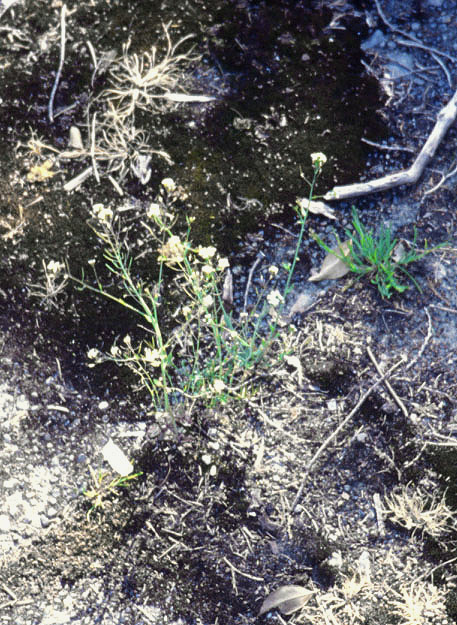
|
| Thale Cress; Arabidopsis Thaliana (L.) Heynh. |
Mustard Family; CRUCIFERÆ (BRASSICACEÆ)
|
| Thale Cress is a tiny, weak, very skinny, pale delicate herb. It ranges in size from moss-like minuteness in which it flowers when only 1/4 - 1 inch tall --or at best produces its basal leaves more than 2 inches long and throws up thin, wiry stems as long as 34 inches to create a mini tumbleweed effect; a study in tenuity. In any case, most sprout in late winter or early spring, bloom in April and May, then die when conditions become too dry in June. It prefers full sun or weak shade, and usually grows on ground that is poor, mossy, gravelly, and exposed. |
| What harm or good is it? Imagine a flowerbed of blooming tulips or primroses, otherwise impeccable save for the presence of a scrawny multitude of Thale Cresses. Surely neither the tulips nor primroses mind such a wispy little companion, yet sensitive human viewers of the scene may feel offended, much like the case of a gnat in a bowl of soup: absolutely harmless per se, but annoying diners. |
| Re. eating, Thale Cress can be a fairly tasty cup of soup itself, being well flavored. Where lettuce is too weak (water and crunch) and mustard greens too strong (green fire), let it fit the bill. Of course its tiny "mouse-ear" leaves are mostly flat on the ground, thus dirty and slug-ridden, but the stem tips, including the elfin white flowers and tender young seedpods, taste good, even though they are so insubstantial that in order to gather a belly-full a person needs literally hundreds. This difficulty, plus the fact that many of its cousins have much the same flavor yet are bigger and about as common, explains the absence of Thale Cress from guides to edible wild plants. For why eat crabapples if normal apples are available? Of nearly 50 species of the Mustard Family known to grow wild in Seattle, only one (Whitlow Grass) grows consistently smaller than Thale Cress. |
Effective persecution is to pull it up, knock it down, or turn it under before the seedpods have time to ripen and release their cargo. The pods, a bit over 1/2 inch long, do not forcibly spit-out their ripe seeds as do some cousins. Due to its extremely short lifespan, gardeners find this homely Eurasian dwarf difficult to eradicate. In contrast, scientists find it valuable in genetic studies (it is a haploid, 2n = 10). "Thale Cress" is a book name preserving the memory of Johann Thal (1542 - 1583), a German doctor and pioneer botanist. Other names are: Mouse-ear (Cress), Common Wall Cress, and Lime.
|
Originally published as the Seattle Tilth newsletter Weed of the Month in April 1986, along with an illustration drawn by Jerri Geer.
Back |
|
|

